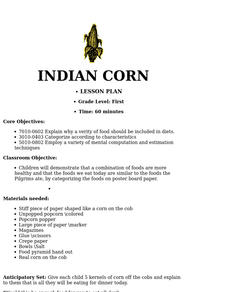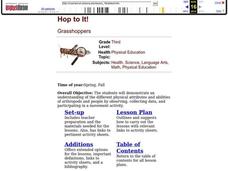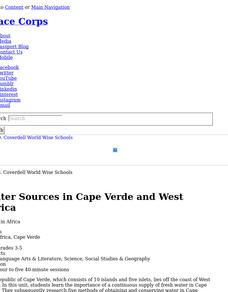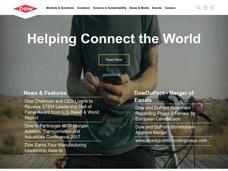Curated OER
Name that Bone
Students name the bones in the skeletal system according to the layman and medical terms of each of the predetermined bones.
Curated OER
Tet, the Vietnamese New Year
Students identify the similarities and differences between traditions in the Vietnamese New Year, TET, with the traditions of several holidays celebrated in America.
Curated OER
Indian Corn
First graders demonstrate that eating combinations of food is very healthy. They discover that foods we eat today are similar to the foods the Pilgrims ate by categorizing the foods on poster board paper.
Curated OER
Food to Grow On
First graders observe, predict, and record food consumption and growth of insects through experimentation with caterpillar diets. They relate their findings to their own growth and diet.
Curated OER
Munching on Mixtures
Students predict, observe, and record what grasshoppers eat to demonstrate an understanding that grasshoppers and people have nutritional requirements to grow and maintain good health.
Curated OER
Hop to It!
Third graders demonstrate an understanding of the different physical attributes and abilities of arthropods and people by observing, collecting data, and participating in a movement activity.
Curated OER
Victorian Philosophies in the Connecticut River Valley: The Connection between Mind, Body, and Spirit
Eleventh graders explore late 19th century concepts of physical and spiritual health, which includes spiritualist and conservation movements, heath tonics, the perceived relationship between climate and physical well being.
Curated OER
Water Sources in Cape Verde and West Africa
Learners analyze the importance of a fresh water supply in Cape Verde, researching five methods of obtaining and conserving water there. Students create and present displays demonstrating their understanding of the methods of water...
Curated OER
Weightlessness
Students use a coffee cup to demonstrate weightlessness. After a lecture/demo, students read an article on free-fall. They perform a simple experiment which helps them explain the concept of weightlessness.
Curated OER
Tracking a Legislator
Students track a member of the Connecticut legislature whose political life and choices during the course of the semester provide the opportunity for students to gain greater civic literacy and understanding through in-depth,...
Curated OER
Climate in Our Back Yard
Learners construct a "A Year in Pennsylvania" poster on which they creatively describe at least three examples of how the climate they live in shapes their lives during every season of the year.
Curated OER
Soil and Agriculture:Lesson 3 - Soil Erosion
Students reseach the different types of soil erosion and ways to control it in this series of activities.
Curated OER
A Monster's World
Study African American inventor Jan Ernst Matzeliger and create imaginary monsters using texture.
Curated OER
Getting the "Yuck" Out
Students examine various types of household materials for their usefulness as filters. They work together in teams to design a filtration system that produces the cleanest water in the shortest time.
Curated OER
Testing Water for Hardness
Students discuss the nature, cause and effect of hard water. Each student conducts a soap test on a sample of hard water where the hardness is known measuring the height of the bubbles produced.
Curated OER
Using Soap Foam to Alter the Density of Plaster of Paris
Students determine the density of Plaster of Paris that has been prepared with a foam generated from dishwashing liquids and shampoo.
Curated OER
Through Thick or Thin!!!
Young scholars differentiate between high and low viscosity. Students collect, graph, and interpret data, then quantitatively measure polymer solids. Young scholars experiment with a household example of an emulsion polymer.
Curated OER
Testing Density of Various Soap Products
Middle schoolers have the opportunity to observe, measure and analyze the density of aerosol shaving creams and foams generated from shampoo and dishwashing liquids or detergents.
Curated OER
Determination of Tensile Stress-Strain Common Properties in Materials
Students demonstrate the relationship between stress and strain, then graph stress-strain curves for various common materials. Students interpret graphed results and discuss differences in mechanical properties of materials.
Curated OER
Is There A Fungus Among Us?
Students experiment with fungi and yeast in order to determine their role in nature. Students study terms associated with fungi and yeast through this series of lessons.
Curated OER
Chlorophyll
Students use thin layer chromatography, TLC, to separate various pigments found in plants.
Curated OER
A Natural Habitat: What, How and Why
Learners understand what a habitat is. They determine why a habitat is important to our environment no matter where it is located. Students observe and recognize natural habitats in their surroundings.
Curated OER
Amylase Enzyme In Saliva
Students test for amaylase enzyme in a variety of substances. Student pairs perform a series of tests to determine how long it takes the starch sample to change to sugar molecules and the blue color to disappear when various saliva...
Curated OER
Earthquake Waves And Their Destructions
Students investigate primary and secondary waves and how to measure the magnitude of waves. They discover how to find the epicenter of earthquakes. They examine why waves are more destructive in some areas than others through these...
Other popular searches
- Spring Festival
- Springboard
- Spring Acrostic
- Spring Art
- Spring Time
- Spring Bulletin Board Ideas
- Spring Haiku Poetry
- Spring Art Lesson Plans
- Spring Lesson Plans
- Spring Theme
- Spring Lessons
- Writing Activities Spring

























